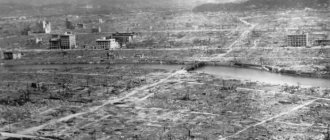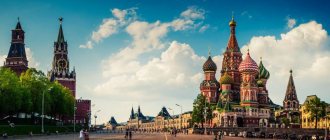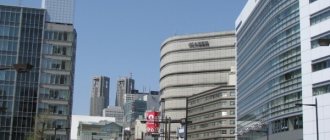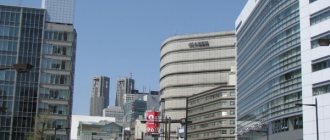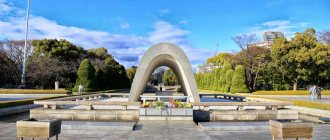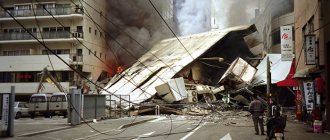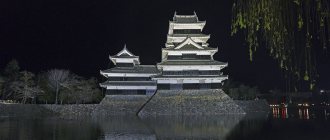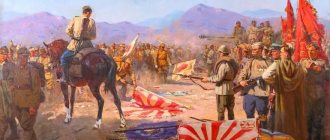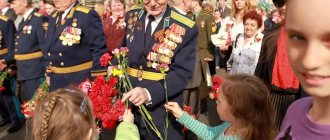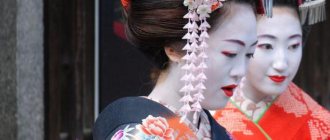The atomic bombings of Hiroshima and Nagasaki, carried out on August 6 and 9, 1945, are the only two examples in the history of mankind of the combat use of nuclear weapons.
The US military dropped two atomic bombs on the Japanese cities of Hiroshima and Nagasaki , killing more than 200,000 people.
In this article we will look at the causes and consequences of this terrible tragedy of the 20th century.
Japan at the end of World War II
As you know, Nazi Germany capitulated on the night of May 9, 1945. However, since Japan was an ally of Nazi Germany, the countries of the anti-fascist coalition declared war on it.
Within a month, as a result of fierce fighting, the Japanese were forced to leave Indochina and Indonesia. An interesting fact is that on July 26, China, Great Britain and America presented an ultimatum to the Japanese, which was subsequently rejected.
At this time, the Soviet Union also officially declared war on Japan. Less than a month later, Soviet troops completely defeated the enemy army. As a result of this, the disputed Kuril Islands and South Sakhalin became part of the USSR (see interesting facts about Sakhalin).
Prerequisites for the use of atomic weapons
Long before the events described above, in the fall of 1944, the leaders of the United States and Great Britain discussed the issue of the possible use of atomic bombs against Japan.
From that moment on, the famous Manhattan Project was launched, which resulted in the creation of super-powerful nuclear weapons.
Manhattan Project
In 1939, physicists led by Albert Einstein reported to US President Franklin Roosevelt that Hitler's Germany was close to creating an atomic bomb.
This prompted the American authorities to become interested in nuclear weapons, writes RT. Then, in 1939, they founded the Uranium Committee at the US National Defense Research Committee. It employed Americans, representatives of Great Britain and Canada, and emigrants from Germany. In 1943, the organization opened the Manhattan Project. His goal was to create nuclear weapons ready for use.
Already in the summer of 1945, the Americans prepared three nuclear bombs - the plutonium “Thing” and “Fat Man” and the uranium “Baby”.
The first explosion, a test, was carried out on July 16, 1945. Then the “Thing” exploded at a test site in New Mexico.
Reasons for the bombing of Hiroshima and Nagasaki
After the end of the war, the United States became the sole owner of nuclear weapons. Wanting to show their military power to the Soviet Union, they began to develop a project for a future bombing.
Nuclear mushroom over Hiroshima (left) and Nagasaki (right)
Japan was in this regard an ideal target for a strike, since, despite its defeats at the front, it was not going to capitulate.
According to the official US version, they dropped atomic bombs on Hiroshima and Nagasaki only because they did not want to sacrifice the lives of their own and allied soldiers in the event of a land invasion of Japan.
In their opinion, the bombing of Hiroshima and Nagasaki was the only way to quickly end the military conflict.
However, this is hardly true, since Winston Churchill, shortly before the Potsdam Conference, claimed that, according to Joseph Stalin, the Japanese want to establish a peaceful dialogue with the countries of the anti-fascist coalition.
Therefore, why attack a country that intends to negotiate?
However, apparently, the Americans really wanted to demonstrate their military potential and show the whole world the weapons of mass destruction that they have.
Japan was the ideal target for this terrible demonstration.
Strategic relevance
If the Japanese weren't worried about the bombing of cities in general and the atomic bombing of Hiroshima in particular, then what were they worried about? The answer to this question is simple : the Soviet Union .
The Japanese found themselves in a rather difficult strategic situation. The end of the war was approaching, and they were losing the war. The situation was bad. But the army was still strong and well supplied. four million men under arms , and 1.2 million of that number were guarding the Japanese islands.
Even the most unyielding Japanese leaders understood that it was impossible to continue the war. The question was not whether to continue it or not, but how to end it on the best terms. The Allies (the United States, Great Britain and others - remember that the Soviet Union at that time still maintained neutrality) demanded “unconditional surrender.” Japan's leadership hoped that it would somehow be able to avoid military tribunals, maintain the existing form of government and some of the territories seized by Tokyo: Korea, Vietnam, Burma , parts of Malaysia and Indonesia , large parts of eastern China and numerous islands in the Pacific Ocean .
They had two plans for obtaining optimal surrender conditions. In other words, they had two strategic options. The first option is diplomatic. In April 1941, Japan signed a neutrality pact with the Soviets, which expired in 1946. A group of mostly civilian leaders, led by Foreign Minister Togo Shigenori, hoped that Stalin could be persuaded to mediate between the United States and its allies and Japan to resolve the situation.
Although this plan had little chance of success, it reflected sound strategic thinking. After all, the Soviet Union is interested in ensuring that the terms of the settlement are not very favorable for the United States - after all, increasing American influence and power in Asia would invariably mean weakening Russian power and influence.
The second plan was military, and most of its supporters, led by Army Minister Anami Koretika , were military men. They hoped that when the American troops began to invade, the imperial ground forces would inflict huge losses on them. They believed that if they succeeded, they would be able to wrest more favorable terms from the United States. This strategy also had little chance of success. The United States was determined to obtain unconditional surrender from the Japanese. But since there was concern in US military circles that the casualties of an invasion would be prohibitive, there was a certain logic to the Japanese high command's strategy.
To understand what the true reason was that forced the Japanese to surrender - the bombing of Hiroshima or the declaration of war by the Soviet Union, it is necessary to compare how these two events affected the strategic situation.
After the atomic attack on Hiroshima, both options were still in force as of August 8th. Another option was to ask Stalin to act as a mediator (Takagi's diary contains an entry dated August 8 that shows that some Japanese leaders were still thinking about involving Stalin). It was still possible to try to fight one last decisive battle and inflict great damage on the enemy. The destruction of Hiroshima did not in any way affect the readiness of the troops for a stubborn defense on the shores of their native islands.
View of bombed-out areas of Tokyo, 1945. Next to the burned down and destroyed neighborhoods is a strip of surviving residential buildings. (USAF)
Yes, there was one less city behind them, but they were still ready to fight. They had enough ammunition and shells, and the combat power of the army, if it decreased, was very small. The bombing of Hiroshima did not predetermine either of Japan's two strategic options.
However, the effect of the Soviet Union's declaration of war and its invasion of Manchuria and Sakhalin Island was completely different. When the Soviet Union entered the war with Japan, Stalin could no longer act as a mediator - he was now an adversary. Therefore, the USSR, through its actions, destroyed the diplomatic option to end the war.
The impact on the military situation was no less dramatic. Most of the best Japanese troops were in the southern islands of the country. The Japanese military correctly assumed that the first target of an American invasion would be the southernmost island of Kyushu. The once powerful Kwantung Army in Manchuria was extremely weakened as its best units were transferred to Japan to organize the defense of the islands.
When the Russians entered Manchuria , they simply crushed the once elite army, and many of their units stopped only when they ran out of fuel. The Soviet 16th Army, numbering 100,000 men, landed troops in the southern part of Sakhalin . She was ordered to break the Japanese resistance there and then, within 10 to 14 days, prepare for an invasion of Hokkaido , the northernmost of the Japanese islands. Hokkaido was defended by the Japanese 5th Territorial Army, which consisted of two divisions and two brigades. She concentrated on fortified positions in the eastern part of the island. And the Soviet offensive plan included a landing in the west of Hokkaido.
Destruction in residential areas of Tokyo caused by American bombing. The photo was taken on September 10, 1945. Only the strongest buildings survived. (AP Photo)
It doesn’t take a military genius to understand: yes, it is possible to conduct a decisive battle against one great power landing in one direction; but it is impossible to repel an attack by two great powers attacking from two different directions. The Soviet offensive invalidated the military strategy of the decisive battle, just as it had previously invalidated the diplomatic strategy. The Soviet offensive was strategically decisive because it deprived Japan of both options. But the bombing of Hiroshima was not decisive (because it did not exclude any Japanese options).
The entry of the Soviet Union into the war also changed all calculations regarding the time remaining to complete the maneuver. Japanese intelligence predicted that American troops would begin landing only in a few months. Soviet troops could actually find themselves on Japanese territory in a matter of days (within 10 days, to be more precise). The Soviet offensive confused all plans regarding the timing of a decision to end the war.
But Japanese leaders came to this conclusion several months earlier. At a meeting of the Supreme Council in June 1945, they declared that if the Soviets entered the war, "it will determine the fate of the empire ." Deputy Chief of Staff of the Japanese Army Kawabe said at that meeting: “Maintaining peace in our relations with the Soviet Union is an indispensable condition for continuing the war.”
Japanese leaders stubbornly refused to show interest in the bombing that destroyed their cities. It was probably wrong when the air raids began in March 1945. But by the time the atomic bomb fell on Hiroshima, they were right to view the bombing of cities as an unimportant sideshow with no serious strategic consequences. When Truman uttered his famous phrase that if Japan did not capitulate, its cities would be subjected to a “destroying shower of steel,” few in the United States realized that there was almost nothing to destroy there.
Charred corpses of civilians in Tokyo, March 10, 1945 after the American bombing of the city. 300 B-29s dropped 1,700 tons of incendiary bombs on Japan's largest city, killing 100,000 people. This air raid was the most brutal of the entire Second World War. (Koyo Ishikawa)
By August 7, when Truman made his threat, there were only 10 cities in Japan with populations over 100,000 that had not yet been bombed. Nagasaki was struck , and nine such cities remained. Four of them were on the northern island of Hokkaido, which was difficult to bomb because of the great distance to the island of Tinian, where American bomber aircraft were stationed.
Secretary of War Henry Stimson removed Japan's ancient capital from his list of bomber targets because it had important religious and symbolic significance. So, despite Truman’s menacing rhetoric, after Nagasaki there were only four large cities left in Japan that could be subjected to atomic strikes.
The thoroughness and scope of the bombing of the American Air Force can be judged by the following circumstance. They bombed so many Japanese cities that they were eventually forced to attack population centers of 30,000 or fewer. In the modern world, it is difficult to call such a settlement a city.
Of course, it was possible to re-strike cities that had already been firebombed. But these cities were already destroyed by an average of 50%. Additionally, the United States could drop atomic bombs on small towns. only six such untouched cities (with a population of 30,000 to 100,000 people) in Japan . But since 68 cities in Japan had already been seriously damaged by bombing, and the country's leadership did not attach any importance to this, it was hardly surprising that the threat of further airstrikes could not make much of an impression on them.
The only thing that retained at least some form on this hill after the nuclear explosion were the ruins of the Catholic Cathedral, Nagasaki, Japan, 1945. (NARA)
Selecting targets for an atomic strike
Having decided to use atomic weapons, the Americans formed a special committee. Committee members were to select Japanese cities on which bombs would subsequently be dropped. The main criteria when choosing goals were:
- Mandatory presence of civilian objects around the selected target;
- The high significance of the object, the destruction of which would cause a great resonance in society;
- Cities must not have been damaged by previous bombings for the destructive power of atomic weapons to be accurately assessed;
- The destruction of the selected object should entail not only economic losses, but also psychological ones.
Potential cities for bombing
Potential cities targeted for bombing included Kyoto, Hiroshima, Yokohama and Kokura. In these four megacities, military enterprises were located, as well as industrial facilities that played an important role in the country's economy.
There is an opinion that Kyoto was originally supposed to be one of the two cities, but US Secretary of War Stimson rejected this proposal. He explained this by the fact that Kyoto had many different attractions and historical monuments.
An interesting fact is that the bombings of Hiroshima and Nagasaki were not seriously considered by the commission members. More precisely, the second city attacked was supposed to be Kokura, but ultimately the atomic bombs were dropped on Hiroshima and Nagasaki.
Scale
In historical terms, the use of the atomic bomb may seem to be the most important single event in the war. However, from the point of view of modern Japan, the atomic bombing is not as easy to distinguish from other events as it is difficult to distinguish a single drop of rain in the middle of a summer thunderstorm.
A US Marine looks through a hole in the wall at the aftermath of the bombing of Naha, Okinawa , June 13, 1945. The city, home to 433,000 people before the invasion, was reduced to ruins. (AP Photo/US Marine Corps, Corp. Arthur F. Hager Jr.)
In the summer of 1945, the US Air Force carried out one of the most intense urban destruction campaigns in world history. In Japan, 68 cities were bombed, and all of them were partially or completely destroyed. An estimated 1.7 million people were left homeless, 300,000 were killed, and 750,000 were injured. 66 air raids were carried out using conventional weapons, and two used atomic bombs.
The damage caused by non-nuclear airstrikes was colossal. All summer, Japanese cities exploded and burned from night to night. In the midst of this nightmare of destruction and death, it could hardly have been a surprise that this or that strike failed to make much of an impact - even if it was delivered by an amazing new weapon.
A B-29 bomber flying from the Marianas could carry a bomb load of 7 to 9 tons, depending on the target location and strike altitude. Typically a raid was carried out by 500 bombers. This means that in a typical air raid using conventional weapons, 4-5 kilotons . (A kiloton is a thousand tons, and is the standard measure of the yield of a nuclear weapon. The Hiroshima bomb had a yield of 16.5 kilotons , and the bomb that fell on Nagasaki had a yield of 20 kilotons .)
With conventional bombing, the destruction was uniform (and therefore more effective ); and one, albeit more powerful bomb, loses a significant part of its destructive force at the epicenter of the explosion, only raising dust and creating a heap of debris. Therefore, it can be argued that some air raids using conventional bombs were close to two atomic bombings .
The first conventional bombing was carried out against Tokyo on the night of March 9–10, 1945. It became the most destructive bombing of the city in the history of war. Then approximately 41 square kilometers of urban area burned in Tokyo. Approximately 120,000 Japanese died. These are the largest losses from the bombing of cities.
Because of the way the story is told, we often imagine that the bombing of Hiroshima was much worse. We think that the death toll is beyond all limits. But if you make a table of the number of people killed in all 68 cities as a result of bombing in the summer of 1945, it turns out that Hiroshima is in second place in terms of the number of civilian deaths.
And if you count the area of destroyed urban areas, it turns out that Hiroshima is the fourth . If you check the percentage of destruction in cities, Hiroshima is in 17th place . It is quite obvious that, in terms of the scale of damage, it fits well within the parameters of air raids using non-nuclear weapons.
From our point of view, Hiroshima is something that stands apart, something extraordinary. But if you put yourself in the shoes of the Japanese leaders in the period preceding the attack on Hiroshima, the picture will look completely different. If you were one of the key members of the Japanese government in late July and early August 1945, you would have felt something like this about the air raids on cities. On the morning of July 17, you would have been told that four cities had been hit by airstrikes during the night: Oita, Hiratsuka, Numazu and Kuwana. Oita and Hiratsuka are half destroyed. In Kuwana, the destruction exceeds 75%, and Numazu suffered the most because 90% of the city burned to the ground.
three more have been attacked . Fukui is more than 80 percent destroyed. A week passes and three more cities are bombed at night. Two days later, bombs fall on six more Japanese cities in one night, including Ichinomiya, where 75% of buildings and structures were destroyed. On August 12, you walk into your office and are told that four more cities have been hit.
Night Toyama, Japan, August 1, 1945, after 173 bombers dropped incendiary bombs on the city. As a result of this bombing, the city was destroyed by 95.6%. (USAF)
Among all these reports, information slips that the city of Toyama (in 1945 it was about the size of Chattanooga, Tennessee) was destroyed by 99.5%. That is, the Americans razed almost the entire city to the ground. On August 6, only one city was attacked - Hiroshima , but according to reports received, the damage there was enormous, and a new type of bomb was used in the airstrike. How does this new air raid compare to other bombings that have lasted for weeks, destroying entire cities?
Three weeks before Hiroshima, the US Air Force carried out raids on 26 cities . Of these, eight (that's almost a third) were either completely destroyed or more severely destroyed than Hiroshima (if you count what part of the cities was destroyed). The fact that 68 cities in Japan were destroyed in the summer of 1945 poses a serious obstacle to those who want to show that the bombing of Hiroshima was the cause of Japan's surrender. The question arises: if they capitulated due to the destruction of one city, then why did they not capitulate when 66 other cities ?
If the Japanese leadership decided to surrender because of the bombing of Hiroshima and Nagasaki, this means that they were worried about the bombing of cities in general, and that attacks on these cities became a serious argument for them to surrender. But the situation looks completely different.
Two days after the bombing of Tokyo , retired Foreign Minister Kijuro expressed an opinion that was openly shared by many senior leaders at the time. Shidehara stated, “People will gradually get used to being bombed every day. Over time, their unity and determination will only strengthen.”
In a letter to a friend, he noted that it was important for citizens to endure suffering because “even if hundreds of thousands of civilians die, are injured and starve, even if millions of homes are destroyed and burned,” diplomacy will take some time. It is appropriate to remember here that Shidehara was a moderate politician.
Apparently, at the very top of state power in the Supreme Council the sentiment was the same. The Supreme Council discussed the importance of the Soviet Union maintaining neutrality - and at the same time, its members said nothing about the consequences of the bombing. From the surviving minutes and archives it is clear that city bombing was mentioned only twice : once in passing in May 1945 and a second time on the evening of August 9, when an extensive discussion on this issue took place. Based on the available evidence, it is difficult to say that Japanese leaders attached any importance to air raids on cities, at least in comparison with other pressing wartime issues.
General Anami noted on August 13 that atomic bombings were no more dangerous than the conventional airstrikes to which Japan had been subjected for several months. If Hiroshima and Nagasaki were no worse than conventional bombings, and if the Japanese leadership did not attach much importance to this, not considering it necessary to discuss this issue in detail, then how could atomic strikes on these cities force them to capitulate?
Fires following the firebombing of the city of Tarumiza , Kyushu , Japan. (USAF)
Bombings of Hiroshima and Nagasaki
Before the bombing of Hiroshima and Nagasaki, the Americans engaged in careful planning. Within a few weeks, the US BBC 509th Airlift Group was reassigned to Tinian Island.
The preparations took place in extreme secrecy. On July 26, an atomic bomb called “Baby” was delivered to Tinian, and 2 days later the main parts of the second bomb, “Fat Man,” arrived.
After this, the US military leadership signed an order authorizing nuclear bombing. Now the Americans could only wait for suitable weather to begin the destruction of Hiroshima and Nagasaki.
Bomb on Hiroshima
The first atomic bomb, called “Baby,” was dropped on Hiroshima on August 6, 1945. Before takeoff, the crew members who had the “honor” of dropping the bomb were confident that they were doing the right thing and doing a good deed for all mankind.
On the left is Major Thomas Ferebee, who dropped the bomb on Hiroshima. On the right is Captain Kermit Behan, who dropped the bomb on Nagasaki.
Interestingly, on the eve of the flight, the pilots even visited the temple. After this, they received an ampoule of potassium cyanide in case they were shot down and captured.
When the pilots boarded the B-29 bomber, which had “Baby” on board, and gained the required altitude, 3 more reconnaissance aircraft took off with them.
Their task was to escort B-29s and also monitor weather conditions. In addition, they had special photographic and video equipment on board, which was supposed to capture the consequences of the explosion.
The flight went well enough, but as we got closer to Japan, tension increased. The weather remained clear and calm.
An interesting fact is that the Japanese did not notice the deadly American planes, which would soon wipe out Hiroshima along with all its inhabitants.
When the B-29 bomber was over Hiroshima at an altitude of about 9 km, a bomb was dropped into the very center of the city.
The time she fell was about 45 seconds. Once at an altitude of 500-600 meters from the ground, “Baby” exploded, as planned.
Photo showing only a few concrete and steel buildings and bridges remaining, September 5
To date, documentary footage of the explosion has been preserved. On them you can see a nuclear mushroom, which was visible at a distance of more than 600 km.
Attractions in Hiroshima
Hiroshima Peace Monument
The biggest tourist attraction is the Peace Monument. Indeed, it is one of the few buildings that survived the atomic bomb and is still standing. At least it's a mostly steel structure that's still standing, and a bright dome. In addition, it is advisable to visit the Hiroshima Peace Memorial Park and Museum.
“Charred bodies were everywhere, including in the river. I looked down and saw a man clutching the hole in his stomach, trying to stop his organs from spilling out. The smell of burning flesh was unbearable."
This is a must visit if you want to learn more about the history of the city and the impact of the American atomic bomb. Volunteers (sometimes war veterans) will show you around the museum. This way you can hear a lot of information and interesting stories about the past.
Hiroshima and Nagasaki. Is President Harry Truman a "killer"? 16+
The Second World War had a big impact on the city and the people, you see it everywhere in the memorial stones and other memorials.
Itsukushima Shrine
Another attraction is Itsukushima Shrine on Miyajima Island. This temple is half underwater at high tide and therefore appears to float. The main attractions of the city are the war monuments, temples and the beautiful nature that you see in the Japanese gardens.
Bomb on Nagasaki
As mentioned above, initially the second bomb was planned to be dropped on Kokura, and not on Nagasaki. However, due to weather conditions, appropriate changes have been made.
Ruins of Nagasaki after the atomic bombing
When the American bomber flew over Kokura, the target was practically invisible due to heavy clouds. Then the leadership gave the order to bomb the “spare” city, which turned out to be Nagasaki.
On the morning of August 9, an American B-29 bomber took off, carrying the Fat Man atomic bomb.
The commander of this operation was Major Charles Sweeney, who subsequently opened the bomb bay.
Survivors of the atomic bombing of Nagasaki among the ruins, amid raging fire, August 9
Interestingly, the local stadium became the reference point for the reset. But fortunately Nagasaki was lucky, as the bomb fell far from its intended target. Thanks to this, the number of victims was much less than the Americans had planned.
Explosion over Hiroshima
Doctor Michihiko Hachiya: “There was nothing left except a few reinforced concrete buildings... Acres and acres of space in the city were like a desert, with only scattered piles of bricks and tiles everywhere. I had to reconsider my understanding of the word "destruction" or find some other word to describe what I saw. Devastation may be the right word, but I don’t really know the word or words to describe what I saw.”
Writer Yoko Ota: “I reached the bridge and saw that Hiroshima had been completely erased from the face of the earth, and my heart trembled like a huge wave... the grief that stepped over the corpses of history pressed on my heart.”
Those who were close to the epicenter of the explosion simply evaporated from the monstrous heat. All that was left of one man was a dark shadow on the steps of the bank where he was sitting. The mother of Miyoko Osugi, a 13-year-old schoolgirl working on fire ditches, did not find her foot in a sandal. The place where the foot stood remained light, but everything around turned black from the explosion.
Those residents of Hiroshima who were far from the epi site survived the explosion, but were seriously injured and received very serious burns. These people were in uncontrollable panic, scrambling for food and water, medical help, friends and relatives, and trying to escape the firestorms that had engulfed many residential areas.
Having lost all orientation in space and time, some survivors believed that they had already died and were in hell. The worlds of the living and the dead seemed to come together.
Protestant priest: “I had the feeling that everyone was dead. The whole city was destroyed... I thought this was the end of Hiroshima - the end of Japan - the end of humanity."
Boy, 6 years old: “There were a lot of dead bodies near the bridge... Sometimes people came to us and asked for water to drink. Their heads, mouths, faces were bleeding, pieces of glass stuck to their bodies. The bridge was on fire... It was all like hell.”
Sociologist: “I immediately thought that it was like hell, which I always read about ... I had never seen anything like it before, but I decided that this must be what hell was like, here it is - the fiery Gehenna, where, as we thought, those who are not saved end up... And I thought that all these people I saw were in the hell that I read about.”
Fifth grade boy: “I had a feeling that all the people on earth had disappeared, and only five of us (his family) remained in the other world of the dead.”
Grocer: “The people looked like... well, they all had blackened skin from burns... They had no hair because the hair had been burned off, and at first glance you couldn't tell whether you were looking at them from the front or the back... Many of them died along the way - I still see them in my mind - like ghosts... They didn’t look like people from this world.”
Consequences of the bombing of Hiroshima and Nagasaki
After the explosion of the atomic bomb, all living things within a radius of 2 km died. Then massive fires began, which became even larger due to the wind.
Today you can see many photographs taken immediately after the tragedy. They show only ruins and completely scorched earth.
After the bombing of Hiroshima and Nagasaki, humanity first encountered the phenomenon of radiation sickness. It seemed that the surviving people initially recovered, but then soon died. A similar thing was observed after the Chernobyl accident.
The symptoms of the unknown illness resembled diarrhea. The surviving people suffered from various diseases all their lives, and were also unable to reproduce full-fledged children.
Carp Castle
Next to the modern, large, shiny neon buildings, there is a historical monument of the city of Hiroshima - Rijo Castle.
Behind the authentic contours of the tower's five floors lies more than 400 years of history. Hiroshima did not yet exist at the time of the founding of the “Carp Castle”. Built by a major feudal lord of medieval Japan, Mori Terumoto (successor of the warlord Mori Takamoto), the castle on an island in the Ota River delta has survived many rulers. During the First World War, the headquarters of the Japanese Armed Forces was located within its walls. But the ancient building no longer survived the Second World War.
The wooden structure, destroyed to its stone foundation, was completely restored after the end of the war. Its walls are built of brick and reinforced concrete, and the outside is decorated with wood. Thus, the castle tower in Hiroshima today looks exactly as it did two hundred years ago. It houses a historical museum where visitors can see real samurai armor, original documents from the times of samurai in scrolls, clothes of the nobility and ordinary people, and feel the atmosphere of everyday life in Japan in the 16th – 18th centuries.
From the territory of the Castle, as well as from its windows, you can see beautiful mountain landscapes and no less amazing views of the city of Hiroshima, where there is a place of both modernity and antiquity.
Photos of Hiroshima and Nagasaki
Here are some photos of Hiroshima and Nagasaki after the bombing:
View of the cloud of the Nagasaki atomic explosion from a distance of 15 km from Koyaji-Jima, August 9, 1945.
According to experts, 5 years after the tragedy, the total number of deaths from the bombings of Hiroshima and Nagasaki was about 200 thousand people.
In 2013, after a revision of the data, this figure more than doubled and was already 450,000 people.
The story of one photographer
On August 10, a Japanese army photographer named Yosuke Yamahata arrived in Nagasaki with the task of documenting the effects of the “new weapon” and spent hours walking through the wreckage, photographing the horror. These are his photographs and he wrote in his diary:
“A hot wind began to blow,” he explained many years later. “There were small fires everywhere, Nagasaki was completely destroyed... we encountered human bodies and animals that lay in our path...”
“It was truly hell on earth. Those who could barely withstand the intense radiation - their eyes burned, their skin “burned” and was ulcerated, they wandered, leaning on sticks, waiting for help. Not a single cloud eclipsed the sun on this August day, shining mercilessly.
Coincidentally, exactly 20 years later, also on August 6, Yamahata suddenly fell ill and was diagnosed with duodenal cancer from the consequences of this walk where he took photographs. The photographer is buried in Tokyo.
As a curiosity: a letter that Albert Einstein sent to former President Roosevelt, where he expected the possibility of using uranium as a weapon of significant power and explained the steps to achieve it.
